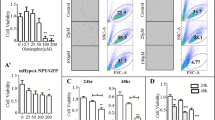Abstract
Zinc is an essential trace element and present at high concentrations in the central nervous system. Recent studies have revealed that excess amount of extracellular zinc is neurotoxic, and that the disruption of zinc homeostasis may be related to various neurodegenerative diseases. Zinc (25–100 μM) caused significant death of immortalized hypothalamic neuronal cells (GT1-7 cells) in a dose- and time-dependent manner. LD50 was estimated to be 34 μM. The degenerated cells were TUNEL-positive and exhibited apoptosis-like characteristics. Preadministration of sodium pyruvate (1–2 mM), a downstream energy substrate, inhibited the zinc-induced neurotoxicity in GT1-7 cells. GT1-7 cells can be used as a good tool for the investigation of zinc neurotoxicity in the hypothalamus.
Similar content being viewed by others
REFERENCES
Frederickson, C. J., Suh, S. W., Silva, D., Frederickson, C. J., and Thompson, R. B. (2000). Importance of zinc in the central nervous system: The zinc-containing neuron. J. Nutr. 130:1471S–1483S.
Hales, T.G., Kim, H., Longoni,B., Olsen, R.W., and Tobin, A. J. (1992). Immortalized hypothalamic GT1-7 neurons express functional γ-aminobutyric acid type A receptors. Mol. Pharmacol. 42:197–202.
Hambidge, M. (2000). Human zinc deficiency. J. Nutr. 130:1344S–1349S.
Harrison, N. L., Gibbons, S. J. (1994). Znp2C: An endogenous modulator of ligand-and voltage-gated ion channels. Neuropharmacology 33:935–952.
Huang, X., Cuajungco, M. P., Atwood, C. S., Moir, R. D., Tanzi, R. E., and Bush, A. I. (2000). Alzheimer's disease, ß-amyloid protein and zinc. J. Nutr. 130:1488S–1492S.
Ishiyama, M., Tominaga, H., Shiga, M., Sasamoto, K., Ohkura, Y., and Ueno, K. (1996).Acombined assay of cell viability and in vitro cytotoxicity with a highly water-soluble tetrazolium salt, neutral red and crystal violet. Biol. Pharm. Bull. 19:1518–1520.
Kawahara, M., Arispe, N., Kuroda, Y., and Rojas, E. (1997). Alzheimer's disease amyloid ß-protein forms Zn2C-sensitive, cation-selective channels across excised membrane patches from hypothalamic neurons. Biophys. J. 73:67–75.
Kawahara, M., Arispe, N., Kuroda, Y., and Rojas, E. (2000). Alzheimer's ß-amyloid, human islet amylin and prion protein fragment evoke intracellular free-calcium elevations by a common mechanism in a hypothalamic GnRH neuronal cell-line. J. Biol. Chem. 275:14077–14083.
Kawahara, M., and Kuroda, Y. (2001). Intracellular calcium changes in neuronal cells induced by Alzheimer's ß-amyloid protein are blocked by estradiol and cholesterol. Cell. Mol. Neurobiol. 21:1–13.
Kim, A. H., Sheline, C. T., Tian, M., Higashi, T., McMahon, R. J., Cousins, R. J., and Choi, D. W. (2000). L-type Cap2C channel-mediated Znp2C toxicity and modulation by ZnT-1 in PC12 cells. Brain Res. 886:99–107.
Koh, J. Y., and Choi, D. W. (1994). Zinc toxicity on cultured cortical neurons: Involvement of N-methyl-D-aspartate receptors. Neuroscience 60:1049–1057.
Koh, J. Y., Suh, S.W., Gwag, B. J., He, Y. Y., Hsu, C. Y., and Choi, D.W. (1996). The role of zinc in selective neuronal death after transient global cerebral ischemia. Science 272:1013–1016.
Lee, J. Y., Kim, Y. H., and Koh, J. Y. (2001). Protection by pyruvate against transient forebrain ischemia in rats. J. Neurosci. 21:RC171.
Liposits, Z., Merchenthaler, I., Wetsel, W. C., Reid, J. J., Mellon, P. L., Weiner, R. I., and Negro-Vilar, A. (1991). Morphological characterization of immortalized hypothalamic neurons synthesizing luteinizing hormone-releasing hormone. Endocrinology 129:1575–1583.
Mellon, P. L., Windle, J. J., Goldsmith, P. C., Padula, J. L., and Weiner, R. I. (1990). Immortalization of hypothalamic GnRH neurons by genetically targeted tumorigenesis. Neuron 5:1–10.
Sheline, C. T., Behrens, M. M., and Choi, D.W. (2000). Zinc-induced cortical neuronal death: Contribution of energy failure attributable to loss of NADC and inhibition of glycolysis. J. Neurosci. 20:3139–3146.
Spergel, D. J., Catt, K. J., and Rojas, E. (1996). Immortalized GnRH neurons express large-conductance calcium-activated potassium channels. Neuroendocrinology 63:101–111.
Sunanda Rao, B. S., and Raju, T. R. (1998). Corticosterone attenuates zinc-induced neurotoxicity in primary hippocampal cultures. Brain Res. 791:295–298.
Takeda, A., Takefuta, S., Okada, S., and Oku, N. (2000). Relationship between brain zinc and transient learning impairment of adult rats fed zinc-deficient diet. Brain Res. 859:352–357.
Weiss, J. H., Hartley, D. M., Koh, J. Y., and Choi, D.W. (1993). AMPA receptor activation potentiates zinc neurotoxicity. Neuron 10:43–49.
Weiss, J. H., Sensi, S. L., and Koh, J. Y. (2000). Znp2C: A novel ionic mediator of neural injury in brain disease. Trends Pharmacol. Sci. 21:395–401.
Wetsel, W. C. (1995). Immortalized hypothalamic luteinizing hormone-releasing hormone (LHRH) neurons: A new tool for dissecting the molecular and cellular basis of LHRH physiology. Cell. Mol.Neurobiol. 15:43–78.
Author information
Authors and Affiliations
Rights and permissions
About this article
Cite this article
Kawahara, M., Kato-Negishi, M. & Kuroda, Y. Rapid Communication: Pyruvate Blocks Zinc-Induced Neurotoxicity in Immortalized Hypothalamic Neurons. Cell Mol Neurobiol 22, 87–93 (2002). https://doi.org/10.1023/A:1015345813075
Issue Date:
DOI: https://doi.org/10.1023/A:1015345813075




